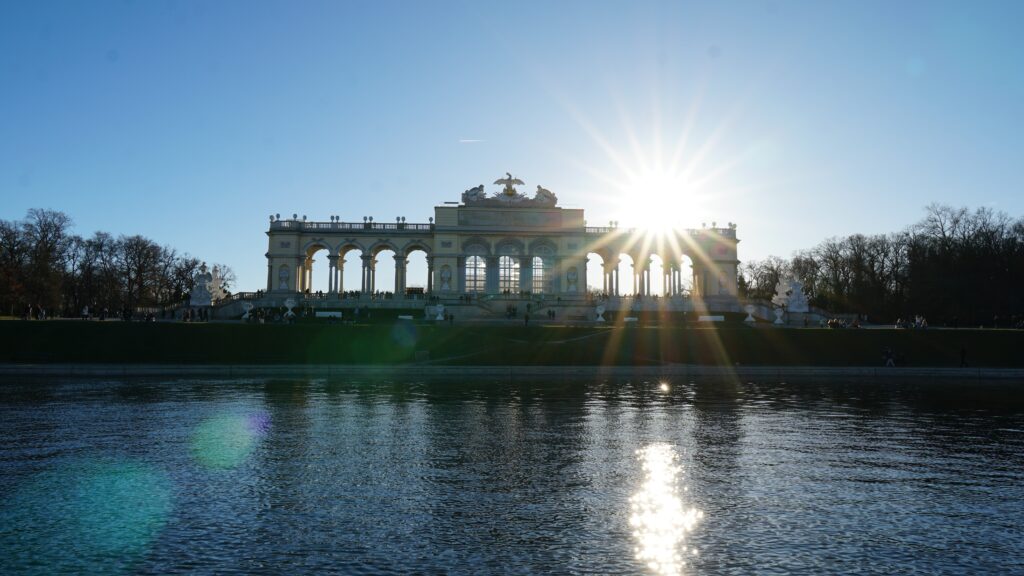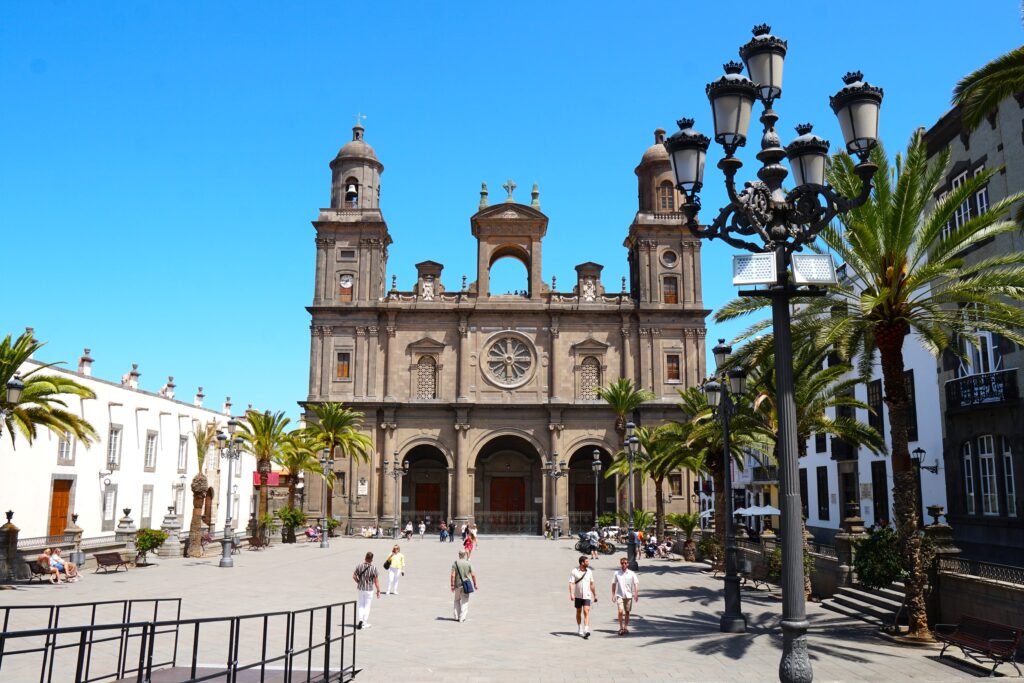Welcome back to another Journey in Vienna! In our previous post, we’ve marveled at the historic charm of the inner city. This time, we will go beyond the city center into Vienna’s imperial past, as we explore two of the city’s most iconic palaces – Belvedere Palace and Schönbrunn Palace.
Located about 20 minutes by subway from the city center, the Baroque grandeur seamlessly continues as you visit the complex of Upper and Lower Belvedere Palaces. It’s surrounded by beautiful gardens. Even in winter, when the garden colors are less vibrant due to fewer flowers and trees in bloom, you should still take a stroll through the exquisite garden where you can enjoy the panoramic views of Vienna’s skyline at every step. For those interested in Gustav Klimt, his works, incl. the famous “The Kiss”, can be seen in the Upper Belvedere.
A little further, about 30 min by subway from the center, lies one of Vienna’s most iconic landmarks – the Schönbrunn Palace. Grab a free audio guide and delve into the interesting anecdotes and history of the Habsburg monarchy, such as how Sisi spent a significant amount of time caring for her long flowing hair, and how she was on a diet to keep her slender figure. Sisi, Empress Elisabeth of Austria, her exceptional beauty, her sorrows, her free spirit and her struggles to adapt to the strict court life are often romanticized in many films and books, contributing to her lasting legacy and the historical significance of the palace.



Vienna is recognized worldwide as the unrivaled “city of music”, owing to its significant role in the development of classical music. During its golden age, its streets echoed with the sounds of musical geniuses such as Mozart, Beethoven, and Strauss. Its musical legacy remains a vital part of the city’s soul. While you’re here, don’t let the chance slip away – attend a live music concert in Vienna, and immerse yourself in the very atmosphere that inspired the greatest musical minds in history.
We were fortunate enough to secure front-row seats to Vivaldi’s “The Four Seasons” at the Karlskirche (also known as St. Charles’ Church). Adding a unique significance to the experience, Vivaldi’s final resting place is said to be near the church. It turned out to be an absolute highlight for us.
Although each concerto is a masterpiece, “Summer” and “Winter” are our favourites.
When Summer awakens with the sound of a thunderstorm, it is as if the soul undergoes an immediate and inescapable renewal. The violinist’s deep and passionate emotions, unfolding freely just a few metres away, immediately transport you into the creator’s passionate and devoted tales of nature, life and love.
Watching the violinist’s deft fingers dance across the strings, and every movement of the bow igniting the fire of life, is like watching an endless yearning for passion. The sound of a summer storm, the biting cold of winter winds – each rustling string evokes vivid feelings that capture the love and pain of life.
The concerto reminds me of Vincent van Gogh’s Wheatfield with Ravens, his last masterpiece before his tragic death. Under a stormy sky, an almost endless golden glow unfolds, dazzling and dangerous at the same time. You feel the approaching danger like a flash of lightning, but you let yourself in.
You can almost hear the sound of a chrysalis tearing itself apart, undergoing the test of metamorphosis, shedding its shell and transforming into a butterfly. Carried by the pain of the past, but filled with the joy of rebirth and the boundless hope of a new tomorrow.
I’m happy to share a short excerpt here so that you can get a deeper impression – these are my favourite passages from ‘Summer’ and ‘Winter’.

Even if you don’t attend any concerts there, Karlskirche is a Baroque masterpiece well worth a visit. Located in Karlsplatz, it offers a glimpse of several of Vienna’s major architectural styles, including Baroque, Art Nouveau, and Neoclassical. And the Musikverein is right across the road!

As the sun sets, ending the day with a delicious Austrian meal becomes almost a necessity. While our previous post focused on the “must-eats,” this time we’ll broaden the horizon and share some of our “lucky finds.”
Let’s begin with an appetizer – Kräftige Rinderbouillon mit Grießnockerl (Hearty Beef Broth with Semolina Dumplings). This traditional dish holds a special place in the hearts of locals, believed to capture the genuine warmth and authentic taste of Austria. It features a semolina dumpling, a beef broth base and carrot strips. The dumplings, made from semolina (a hard type of wheat), eggs and spices, taste very light and tender. They’re gently simmered over a low-heat in a well-seasoned broth until they’re cooked through and takes on the rich flavors of the broth. Its delicate texture harmonizes well with the robust beef flavor, and makes this dish very comforting, rich, and somewhat elegant at the same time

While Vienna’s famous dishes often center around meat, don’t overlook the salad – it’s not just a plate of greens; it’s an art piece that blends diverse flavors, freshness and creativity. You’ll find bright yellow of citrus slices, deep reds of beetroot, and lush greens of fresh vegetables, avocado and cheese that add a nice softness to the crispy ensemble. While the balsamic vinegar can sometimes taste too sharp, in Vienna, it’s often balanced with a subtle sweet note, perhaps from the fresh fruit or a drizzle of honey. The harmonious blend of the diverse ingredients makes you feel like savoring a flouring garden in spring, a sensory experience that mirrors city’s vibrant romantic spirit.


Moving on to the main course, let’s talk about Hirschkalbsrücken (venison loin or the back portion of a young dear). Venison, a game meat, has historical ties to the centuries-old hunting traditions that prevailed in many parts of Europe. In times when hunting was a privilege reserved for the aristocracy, the consumption of game meat, including venison, was often associated with nobility, wealth, and social status, particularly in German-speaking areas during the Middle Ages and Renaissance. Today, venison remains a delicacy in Austria and an integral part of its gastronomic culture, marked by the frequent display of dear heads in gasthauses (traditional inns or taverns) as a tribute to the historical role of hunting in society.
We tried this dish at the Lugeck restaurant, where it’s beautifully presented with root bacon, Brussels sprouts, chestnuts and mashed potatoes. The meat is very lean, tender, but without a trace of pink inside, showing it’s been meticulously cooked through. Seasoned with rosemary, it has a peppery aroma and a fresh resinous, herbal note, perfectly melded with its rich, robust and earthy flavors. The root bacon gives a balance of fat to the lean meat. It’s salty yet savory. The crispy crust on the edges nicely contrasts to the tender venison. Eating alongside with the Brussels sprouts will give you a refreshing note and a gentle touch of bitterness, while glazed chestnuts add a mild sweetness. Just as the medley of tastes unfolds, the mashed potatoes step in, with its velvety comforting creaminess that softens and unifies the diverse flavors, creating a savory complexity that lingers on your taste buds.

Next up is the succulent roasted pork belly at Ofenloch restaurant. It’s served in generous brick-like portions alongside sliced Kartoffelknödel (potato dumplings). The meat is hearty, tender, and rich in fat, which is rendered luxuriously during roasting, making the meat all the juicier. Its softness is a nice counterpoint to the leaner part. Surprisingly, it doesn’t taste overly fatty, instead it silkens the overall flavor. Our favorite part is the skin, roasted to a perfect crunch – it crackles with every bite! Concentrated with essence of seasoning – salty, peppery, a hint of citrus and herbal aroma, the crispy surface adds a layered texture and certainly intensifies the taste.
Potato dumplings are a common accompaniment to Austrian meat dishes. They have a starchy texture that helps absorb the fattiness of the pork belly and balance the meal.

Concluding our culinary exploration today is Wiener Backhendl (also known as Viennese Fried Chicken). This traditional Austrian dish is loved for its flavorful marinade and crispy texture. The special marinade mix gives it a very unique flavor – garlicky, peppery, salty, with a hint of fresh herbaceous taste. Buttermilk is often used too, to add a subtle tanginess to the marinade and help tenderize the meat. An eager bite into the golden-brown crust, all the moist locked within reveals themselves, taking you to a world of juicy savory satisfaction.
Some restaurants serve it with lingonberry sauce. We’d recommend paring it with aioli or a light yogurt-based dip, if available. Their creaminess deftly balances the dryness of the fried chicken without overshadowing its inherent flavors.

With that, our journey through Vienna comes to an end. Thank you for staying with us until the end. If our content has brought you some inspiration, enriching your (next) visit to Vienna, we will be truly grateful. For any questions or suggestions, feel free to reach out to us. While our focus has been on local traditional Viennese cuisine, the city’s culinary offerings extend far beyond that. There are numerous international dining options, and in the upcoming posts, we will spotlight one of our top picks. Stay tuned for more – see you soon!




